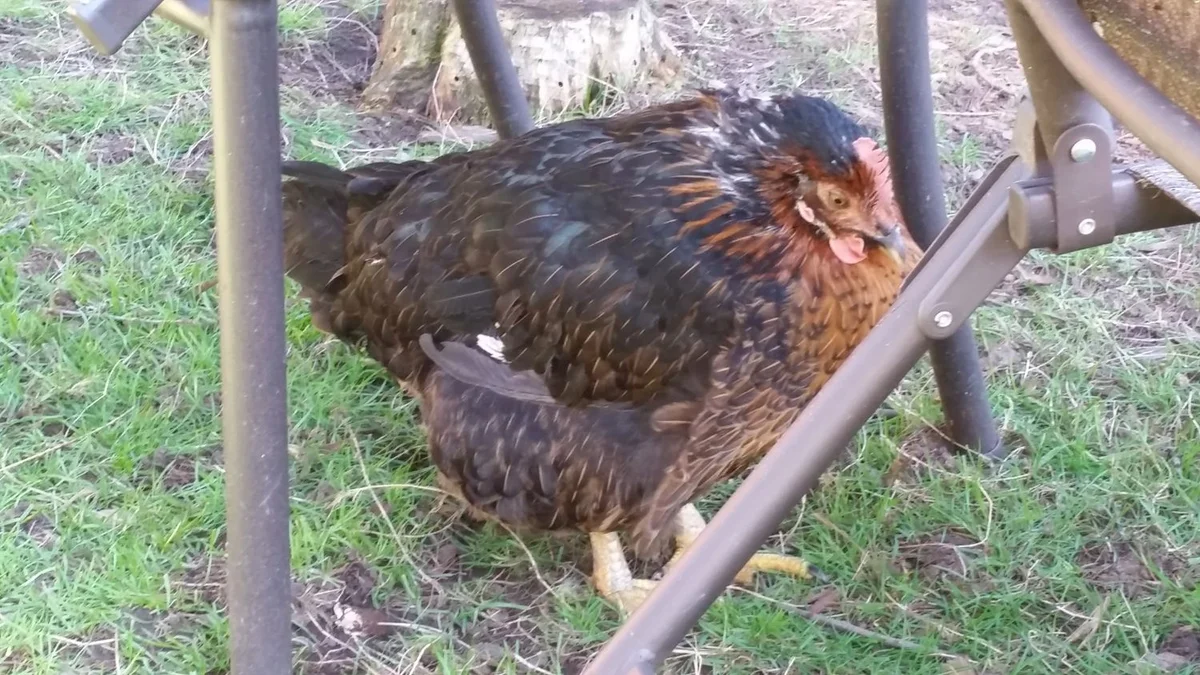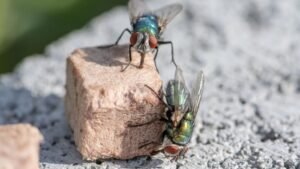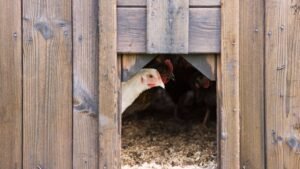It’s a heart-sinking feeling to see a normally active chicken suddenly become quiet and listless. The vibrant, busy member of your flock is now huddled in a corner, barely moving. Lethargy is a serious and non-specific symptom, meaning it can be a sign of many different underlying issues, from a simple case of dehydration to a life-threatening illness.
This guide is designed to be your calm, step-by-step resource to help you quickly assess the situation. We’ll walk you through immediate first-aid steps, help you become a detective to spot other symptoms, and provide a comprehensive checklist of common causes so you can make an informed decision on what to do next.
The First Aid Protocol: What to Do Immediately
Before you even begin diagnosing the problem, take these critical, immediate steps to help your chicken. These actions can significantly improve her chances of recovery, regardless of the cause.
- Isolate the Chicken: This is the most important step. Immediately separate the sick chicken from the rest of the flock. This prevents the spread of any potential contagious disease and ensures the sick bird has a chance to rest without being bullied or pecked by her flockmates. A large dog crate or a carrier with good airflow makes a perfect isolation room.
- Provide a Calm, Warm Space: Place your chicken in a quiet, stress-free environment, such as a sturdy cardboard box with clean, soft bedding. The ideal temperature for a sick chicken is between 75circ and 80circ Fahrenheit. You can provide warmth with a heat lamp positioned at one end of the box or a hot water bottle wrapped in a towel. This allows her to move away from the heat if she gets too warm.
- Offer Water and Food: Make sure your chicken has immediate access to clean, fresh water. If she isn’t drinking on her own, gently dip her beak into the water to encourage her. Offer a small amount of easy-to-digest food, like scrambled eggs, plain oatmeal, or moistened chick feed. These soft foods require less energy to consume and provide essential nutrients.
- Observe Closely: Become a detective. While your chicken is resting, observe her for any other symptoms. Pay close attention to her droppings (color, consistency, and any blood), her posture, how she’s holding her wings, and the color of her comb and wattles. This information will be vital for diagnosis.
Important Note: This guide is for informational purposes only. Lethargy is a serious symptom, and a hands-on examination by a qualified veterinarian is always the best course of action for an accurate diagnosis and treatment plan.
The first aid protocol is an essential starting point, but knowing what a healthy chicken looks like is just as important. In the next section, we’ll cover the key signs of lethargy and what to look for when you’re checking on your flock.
What Does a Lethargic Chicken Look Like? The Key Signs
Lethargy is often a chicken’s first and most prominent sign of illness. It’s a general symptom that you must pair with other clues to narrow down the problem. Look for these key signs:
- Hunched posture, fluffed-up feathers: This is a classic sign of a sick chicken trying to conserve body heat. She’ll appear smaller, with her head tucked in and her feathers puffed out to trap air against her body.
- Closed or half-closed eyes: A healthy chicken is alert and observant. A chicken with no energy will often stand still with her eyes closed, as if she’s falling asleep. This indicates profound weakness or pain.
- Lack of interest in food, water, or treats: A healthy chicken’s appetite is voracious. A sudden disinterest is a major red flag, especially if she won’t even take her favorite treats.
- Staying away from the flock: Chickens are social animals, but they also have a strong survival instinct. A sick chicken will often isolate herself to avoid being picked on by her flockmates, as they will instinctively recognize her weakness.
- May be wobbly or off-balance: This can signal a more severe neurological issue, a balance problem, or simply extreme weakness. A wobbly gait or inability to stand upright is a sign of a serious condition.
- Pale comb and wattles: A healthy comb is vibrant and red. Paleness can indicate anemia, dehydration, or poor circulation. In severe cases, they may appear grayish or bluish.
Now that you know what to look for, let’s get organized.
A Chicken Health Checklist: Your Diagnostic Tool
Before diving into the specific causes, use this checklist to systematically gather your observations. Having these notes ready will help you pinpoint the most likely issue from the list below and will be invaluable if you need to call a veterinarian.
- Overall Behavior:
- Is the chicken isolated or with the flock?
- Is she moving normally or is she lethargic/wobbly?
- Is she eating and drinking?
- Physical Appearance:
- Are her feathers fluffed up or hunched?
- What color are her comb and wattles? (Healthy is vibrant red)
- Are her eyes clear, or are they swollen or watery?
- Droppings:
- What is the color and consistency? (Normal is firm, brown with a white cap)
- Is there blood, or are they watery?
- Are there any visible worms?
- Respiration:
- Is she breathing normally?
- Are there any gurgling, sneezing, or rattling sounds?
- Is her beak open (panting)?
- Crop:
- Is the crop hard, squishy, or empty in the morning?
- Legs and Feet:
- Are there any limps, swollen joints, or scaly appearance on the legs?
With your observations in hand, let’s explore the most common reasons your chicken might be lethargic.
The 17 Common Causes of Lethargy in Chickens
This list is organized by category to help you efficiently connect the symptoms you’ve observed with a potential cause.
Category 1: Environmental & Physical Issues
- Dehydration:
- Symptoms: Pale, shrunken comb, panting, thick saliva, reluctance to move, sunken eyes. You can test for dehydration by gently pinching the skin on her leg—if it doesn’t snap back into place immediately, she is dehydrated.
- What to Do: Provide fresh, cool water immediately. Add a commercial poultry electrolyte supplement to the water to help her rehydrate quickly and replenish lost minerals.
- Heat Stress/Exhaustion:
- Symptoms: Panting with her beak open, holding wings away from her body to dissipate heat, pale comb, squatting low to the ground.
- What to Do: Move her to a cool, shaded area. Offer cool (not icy) water and a cool bath for her feet and legs. You can also spritz her with a little cool water to help bring her body temperature down.
- Injury:
- Symptoms: Limping, reluctance to bear weight on a leg, visible cuts, abrasions, or broken bones.
- What to Do: Carefully examine her for any wounds or signs of trauma. Clean any wounds with a pet-safe antiseptic solution like Vetericyn and isolate her in a quiet space to heal without being disturbed.
- Bullying/Stress:
- Symptoms: Hiding, feather loss from pecking, reluctance to come out for food or water, a general fear or nervousness around other chickens.
- What to Do: Observe flock dynamics. If you identify a bully, consider culling or isolating the aggressive bird. Keep the bullied bird isolated until she feels safe and has recovered her energy.
Category 2: Parasites (The Hidden Invaders)
- Mites or Lice (External):
- Symptoms: Restlessness, excessive scratching, feather loss, scaly legs, visible bugs (if the infestation is heavy) near the vent, and a pale comb due to anemia.
- What to Do: Check your chicken thoroughly by separating the feathers, especially around the vent. Treat the flock and the coop with a poultry-safe dust or administer a proper poultry dewormer.
- Worms (Internal):
- Symptoms: Pale comb, a significant drop in egg production, weight loss despite eating, and you may even see worms visible in droppings.
- What to Do: A fecal test from a vet is the only way to confirm a worm infestation. Once confirmed, administer a proper poultry dewormer like Ivermectin or Safeguard.
Category 3: Digestive & Crop Problems
- Coccidiosis:
- Symptoms: Bloody or watery droppings, hunched posture, ruffled feathers, rapid weight loss, and extreme lethargy.
- What to Do: This is a serious parasitic disease that can be fatal. Treat immediately with a coccidiostat like Corid (Amprolium) in the water and consult a veterinarian for a proper treatment plan.
- Sour Crop:
- Symptoms: A squishy, fluid-filled crop that feels like a water balloon and doesn’t empty overnight. A foul, sour smell from her beak is a definite sign.
- What to Do: Isolate the chicken. Gently massage the crop to encourage emptying. You can offer water with a small amount of Apple Cider Vinegar to help balance the crop’s pH.
- Impacted Crop:
- Symptoms: A hard, firm crop that feels like a golf ball and doesn’t empty overnight. The chicken will likely stop eating.
- What to Do: Gently massage the crop with warm water and a little bit of olive oil. Withhold food, but continue to provide water. If it doesn’t resolve in 24 hours, it may require veterinary intervention as it can be a blockage.
Category 4: Reproductive Issues (Hens)
- Egg Bound:
- Symptoms: Waddling like a penguin, straining, a swollen abdomen, spending a lot of time in the nest box, and a lack of appetite. You may be able to feel an egg stuck in her abdomen.
- What to Do: This is an emergency. Provide a warm, dark, quiet space. A warm bath with Epsom salts can help relax her muscles and encourage her to pass the egg. If she cannot pass it, a vet visit is crucial.
Category 5: Infectious Diseases
- Respiratory Infection:
- Symptoms: Sneezing, coughing, watery eyes or nostrils, gurgling sounds, rattling in the chest, and swelling around the eyes.
- What to Do: Isolate the chicken immediately to prevent spread. Ensure good ventilation in the coop and contact a vet for antibiotics, as a bacterial infection is a common cause.
- Gumboro Disease (IBD):
- Symptoms: Severe prostration (inability to move), watery diarrhea, trembling, and a reluctance to eat.
- What to Do: This is a highly contagious viral disease that affects the immune system. There is no cure, so supportive care and strict biosecurity are key to survival and preventing its spread.
- Marek’s Disease:
- Symptoms: Paralysis of a leg or wing (“splits”), loss of appetite, and a general lack of energy.
- What to Do: This is a viral disease with no cure. The best prevention is through vaccination of chicks at the hatchery.
- Avian Influenza:
- Symptoms: Sudden death, extreme lack of energy, purple discoloration of the comb and wattles, swelling of the head, and a drop in egg production.
- What to Do: This is a serious, reportable disease. Contact your local department of agriculture or veterinarian immediately.
Category 6: Other Potential Causes
- Poisoning:
- Symptoms: Sudden onset of severe symptoms, seizures, diarrhea, and a lack of coordination.
- What to Do: Try to identify the source of the poisoning. If you suspect she has ingested something toxic, call a vet or animal poison control for guidance.
- Old Age:
- Symptoms: A general slowing down over time, reduced activity, and a decline in egg production.
- What to Do: Provide supportive care, easy access to food and water, and a comfortable space for her to rest. Old hens may require a more specialized diet.
- Broodiness:
- Symptoms: A hen sitting in the nest box for long periods, flattened posture, growling or pecking when approached.
- What to Do: This is a natural state, not an illness. You can gently break the broodiness if you wish by removing her from the nest box, but otherwise, let her be.
Now that you have the tools to identify the potential problem, let’s look at how you can provide hands-on treatment and care.
What to Give a Lethargic Chicken: Home Remedies & Treatments
Once you have an idea of the cause, here are some supportive treatments you can provide at home.
- Hydration is Key: A dehydrated chicken won’t get better. You can buy commercial electrolytes for poultry, or make your own by adding a teaspoon of sugar and a pinch of salt to a cup of water. Gently encourage her to drink with a dropper or syringe.
- Energy Boost: Sugar water can provide a quick, temporary energy boost for a very weak chicken, but it is not a long-term solution. It can help a bird that is too weak to eat on her own by giving her the strength to get up and seek food.
- Supportive Feeds: Offer easy-to-digest foods like scrambled eggs, plain yogurt (the probiotics are great for their gut health), or moistened chick starter feed. Avoid giving hard grains that are difficult to digest.
- Natural Supplements: A small amount of Apple Cider Vinegar in their water can help support their immune systems. Garlic is a natural immune booster and can be crushed and added to their water or feed.
What NOT to Give Your Chicken
- Can I give paracetamol to a chicken? NO. Human painkillers like paracetamol can be toxic and cause organ failure in poultry. Never give any medication without veterinary guidance.
While these home remedies can be a great help, some situations call for professional help. The next section will guide you on when to call the vet.
Knowing When to Call the Vet: Red Flags You Can’t Ignore
While many minor issues can be managed at home, certain symptoms are serious red flags that demand immediate veterinary attention. Don’t hesitate if you see any of the following:
- Purple or Blue Comb/Wattles: This indicates a lack of oxygen and can be a sign of a severe respiratory or circulatory problem.
- Sudden, Unexplained Deaths in the Flock: If you have multiple birds dying suddenly, this could be a sign of a highly contagious and dangerous disease like Avian Influenza. Contact your local department of agriculture or a vet immediately.
- Inability to Stand or Walk: This can be a sign of a severe injury, a neurological issue, or extreme weakness.
- Extreme Swelling: Swelling of the head, neck, or joints could signal a serious bacterial infection or other severe illness.
- Severe Bleeding: Any wound that is bleeding heavily or won’t stop requires professional medical care.
Knowing when to call a vet is the most responsible thing you can do for your flock and the wider poultry community. A professional diagnosis is invaluable for both treatment and disease prevention.
Once you have a treatment plan, the next step is to prepare a safe and comfortable recovery space for your chicken.
Setting Up a Hospital Pen: Your Chicken’s Recovery Room
Once you’ve isolated your sick chicken, a properly set up hospital pen can make all the difference in her recovery. The goal is to create a calm, safe, and easily managed space.
Essential Items for a Hospital Pen
- A Sturdy Container: A large dog crate, a spacious cardboard box, or a modified rabbit hutch works well. It needs to be large enough for the chicken to stand, turn around, and lay down comfortably.
- Soft Bedding: Use clean, dust-free bedding like pine shavings or straw. This provides comfort and makes cleanup easier.
- Heat Source: A heat lamp is the best option for providing a consistent, adjustable source of warmth. Place the lamp at one end of the pen so the chicken can move away from it if she gets too hot. A hot water bottle wrapped in a towel is a good, low-cost alternative.
- Food and Water: Use small, easily accessible feeders and waterers. Consider a chick waterer that prevents splashing and a small dish for food to minimize spills.
- Monitoring Tools: Keep a notebook or a small whiteboard near the pen to jot down observations, medication times, and food/water intake.
A well-equipped hospital pen can be a lifeline for a sick chicken, providing a safe space for her to rest and recover. Now that you’ve handled the immediate crisis, let’s turn our attention to the long-term goal of prevention.
Proactive Prevention: The Best Medicine for Your Flock
The best way to deal with a sick chicken is to prevent them from getting sick in the first place. By practicing good biosecurity and management, you can significantly reduce the risk of illness.
Key Biosecurity Measures
- Limit Visitors: Footwear and clothing can easily carry diseases onto your property. Restrict visitors to your coop area or have them wear dedicated footwear and clothing.
- Quarantine New Birds: Always quarantine new chickens for at least 30 days before introducing them to your existing flock. This allows you to observe them for any signs of illness and prevent the introduction of new diseases.
- Cleanliness is Crucial: Regularly clean and disinfect your coop, feeders, and waterers. A clean environment reduces the chance of bacteria, viruses, and parasites taking hold.
- Pest and Rodent Control: Mice, rats, and insects can carry and spread diseases. Use traps and other safe methods to keep your coop free of pests.
Diet and Health Management
- Provide a Balanced Diet: Feed a high-quality, nutritionally complete feed appropriate for your flock’s age and purpose. Avoid overfeeding scratch grains, which are high in carbohydrates and low in nutrients.
- Offer Fresh Water: Always provide a constant supply of fresh, clean water. Clean waterers daily to prevent the buildup of bacteria and algae.
- Practice Good Ventilation: A well-ventilated coop prevents the buildup of ammonia, a byproduct of chicken droppings that can cause respiratory issues.
By taking these preventative steps, you are not only protecting your own flock, but also helping to maintain the health of the wider poultry community.
Frequently Asked Questions (FAQ)
Q: What are three signs that a chicken may be sick?
A: Three common signs are lethargy (lack of energy), isolation from the flock, and changes in droppings (such as blood or a watery consistency).
Q: How do I help a very lethargic chick?
A: Chicks are extremely fragile. Provide immediate warmth (a brooder is best), offer electrolyte water with a dropper, and check for “pasty butt” (a buildup of fecal matter that blocks the vent).
Q: What are the signs a chicken is dying?
A: Signs include being unresponsive, shallow breathing, inability to stand, and a body that feels cold to the touch. The best thing you can do is provide a peaceful, warm space for her.
Q: How do you treat coccidiosis in chickens naturally?
A: While some herbs and probiotics can support gut health, a confirmed coccidiosis outbreak is severe and usually requires a medicated treatment like Amprolium (Corid) to prevent death. Natural methods are best used for prevention, not a cure.
Conclusion: Your Observation is Your Best Tool
Lethargy is a general alarm, and your job as a chicken keeper is to observe all the other signs to narrow down the cause. The most important things you can do are to provide immediate first aid: isolate, provide warmth, offer hydration, and observe carefully. When in doubt, the safest and kindest thing you can do for your bird is to contact a qualified veterinarian.

Oladepo Babatunde is the founder of ChickenStarter.com. He is a backyard chicken keeper and educator who specializes in helping beginners raise healthy flocks, particularly in warm climates. His expertise comes from years of hands-on experience building coops, treating common chicken ailments, and solving flock management issues. His own happy hens are a testament to his methods, laying 25-30 eggs weekly.



